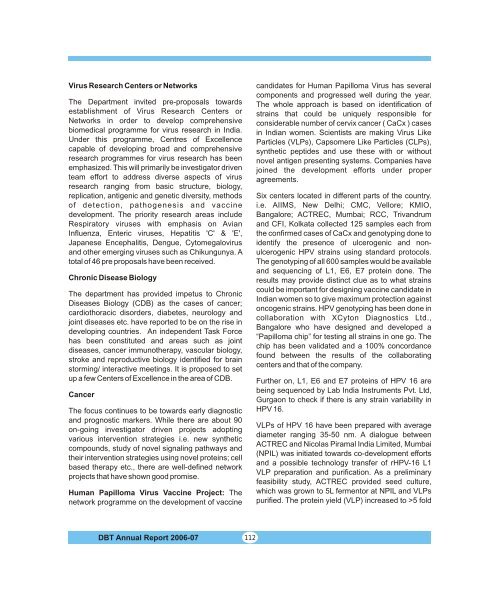ANNUAL REPORT - Department of Biotechnology
ANNUAL REPORT - Department of Biotechnology
ANNUAL REPORT - Department of Biotechnology
You also want an ePaper? Increase the reach of your titles
YUMPU automatically turns print PDFs into web optimized ePapers that Google loves.
Virus Research Centers or Networks<br />
The <strong>Department</strong> invited pre-proposals towards<br />
establishment <strong>of</strong> Virus Research Centers or<br />
Networks in order to develop comprehensive<br />
biomedical programme for virus research in India.<br />
Under this programme, Centres <strong>of</strong> Excellence<br />
capable <strong>of</strong> developing broad and comprehensive<br />
research programmes for virus research has been<br />
emphasized. This will primarily be investigator driven<br />
team effort to address diverse aspects <strong>of</strong> virus<br />
research ranging from basic structure, biology,<br />
replication, antigenic and genetic diversity, methods<br />
<strong>of</strong> detection, pathogenesis and vaccine<br />
development. The priority research areas include<br />
Respiratory viruses with emphasis on Avian<br />
Influenza, Enteric viruses, Hepatitis 'C' & 'E',<br />
Japanese Encephalitis, Dengue, Cytomegalovirus<br />
and other emerging viruses such as Chikungunya. A<br />
total <strong>of</strong> 46 pre proposals have been received.<br />
Chronic Disease Biology<br />
The department has provided impetus to Chronic<br />
Diseases Biology (CDB) as the cases <strong>of</strong> cancer;<br />
cardiothoracic disorders, diabetes, neurology and<br />
joint diseases etc. have reported to be on the rise in<br />
developing countries. An independent Task Force<br />
has been constituted and areas such as joint<br />
diseases, cancer immunotherapy, vascular biology,<br />
stroke and reproductive biology identified for brain<br />
storming/ interactive meetings. It is proposed to set<br />
up a few Centers <strong>of</strong> Excellence in the area <strong>of</strong> CDB.<br />
Cancer<br />
The focus continues to be towards early diagnostic<br />
and prognostic markers. While there are about 90<br />
on-going investigator driven projects adopting<br />
various intervention strategies i.e. new synthetic<br />
compounds, study <strong>of</strong> novel signaling pathways and<br />
their intervention strategies using novel proteins; cell<br />
based therapy etc., there are well-defined network<br />
projects that have shown good promise.<br />
Human Papilloma Virus Vaccine Project: The<br />
network programme on the development <strong>of</strong> vaccine<br />
DBT Annual Report 2006-07<br />
112<br />
candidates for Human Papilloma Virus has several<br />
components and progressed well during the year.<br />
The whole approach is based on identification <strong>of</strong><br />
strains that could be uniquely responsible for<br />
considerable number <strong>of</strong> cervix cancer ( CaCx ) cases<br />
in Indian women. Scientists are making Virus Like<br />
Particles (VLPs), Capsomere Like Particles (CLPs),<br />
synthetic peptides and use these with or without<br />
novel antigen presenting systems. Companies have<br />
joined the development efforts under proper<br />
agreements.<br />
Six centers located in different parts <strong>of</strong> the country.<br />
i.e. AIIMS, New Delhi; CMC, Vellore; KMIO,<br />
Bangalore; ACTREC, Mumbai; RCC, Trivandrum<br />
and CFI, Kolkata collected 125 samples each from<br />
the confirmed cases <strong>of</strong> CaCx and genotyping done to<br />
identify the presence <strong>of</strong> ulcerogenic and nonulcerogenic<br />
HPV strains using standard protocols.<br />
The genotyping <strong>of</strong> all 600 samples would be available<br />
and sequencing <strong>of</strong> L1, E6, E7 protein done. The<br />
results may provide distinct clue as to what strains<br />
could be important for designing vaccine candidate in<br />
Indian women so to give maximum protection against<br />
oncogenic strains. HPV genotyping has been done in<br />
collaboration with XCyton Diagnostics Ltd.,<br />
Bangalore who have designed and developed a<br />
“Papilloma chip” for testing all strains in one go. The<br />
chip has been validated and a 100% concordance<br />
found between the results <strong>of</strong> the collaborating<br />
centers and that <strong>of</strong> the company.<br />
Further on, L1, E6 and E7 proteins <strong>of</strong> HPV 16 are<br />
being sequenced by Lab India Instruments Pvt. Ltd,<br />
Gurgaon to check if there is any strain variability in<br />
HPV 16.<br />
VLPs <strong>of</strong> HPV 16 have been prepared with average<br />
diameter ranging 35-50 nm. A dialogue between<br />
ACTREC and Nicolas Piramal India Limited, Mumbai<br />
(NPIL) was initiated towards co-development efforts<br />
and a possible technology transfer <strong>of</strong> rHPV-16 L1<br />
VLP preparation and purification. As a preliminary<br />
feasibility study, ACTREC provided seed culture,<br />
which was grown to 5L fermentor at NPIL and VLPs<br />
purified. The protein yield (VLP) increased to >5 fold

















